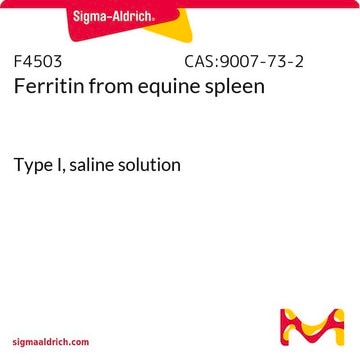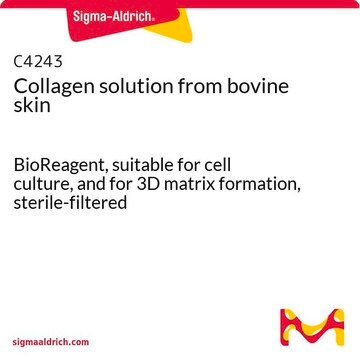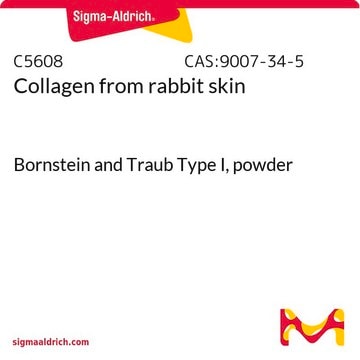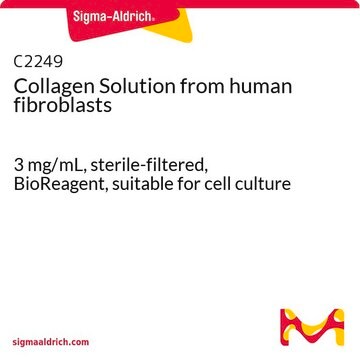C8897
Colágeno
Bornstein and Traub Type I (Sigma Type VII), powder
Faça loginpara ver os preços organizacionais e de contrato
About This Item
Produtos recomendados
fonte biológica
rat tail
forma
powder
técnica(s)
cell culture | mammalian: suitable
solubilidade
aqueous acid: soluble
nº de adesão UniProt
temperatura de armazenamento
2-8°C
Informações sobre genes
rat ... Col1a1(29393)
Procurando produtos similares? Visita Guia de comparação de produtos
Aplicação
This product is intended to produce thin layer coatings on tissue culture plates to facilitate attachment of anchorage-dependent cells, recommended for use at 6-10 μg/cm2. It is NOT intended for production of 3-D gels. Type I collagen is often used in cell culture as an attachment substratum with myoblasts, spinal ganglia, hepatocytes, embryonic lung, heart explants, fibroblasts, endothelial cells, and islet cells have all been cultured successfully on films or gels of type I collagen. Collagen type I may also be used in research of Idiopathic pulmonary fibrosis (IPF), studies on the effect of ER stress IPF on lung fibroblasts. Collagen in acidic solution can produce three dimensional scaffolding with use in bioengineering and cell culture applications.
Ações bioquímicas/fisiológicas
Type I collagen is a component of skin, bone, tendon, and other fibrous connective tissues.
Componentes
All collagen molecules are composed of three polypeptide chains arranged in a triple helical conformation, with a primary structure that is mostly a repeating motif with glycine in every third position and proline or 4-hydroxyproline frequently preceding the glycine residue. Type I collagen differs from other collagens by its low lysine hydroxylation and low carbohydrate composition.
Nota de preparo
This product was prepared by a modification of the extraction method of Bornstein, M.B., Lab. Invest., 7, 134 (1958). It is an acid soluble collagen. It dissolves in water with acetic acid added to pH 3.0 at 5 mg/mL, yielding an opalescent, colorless solution.
Outras notas
O colágeno é classificado em diversos tipos estrutural e geneticamente distintos. Usamos a nomenclatura proposta por Bornstein e Traub. Não confunda as designações de tipos da Sigma com tipos de classificação de colágeno reconhecidos.
Código de classe de armazenamento
11 - Combustible Solids
Classe de risco de água (WGK)
WGK 1
Ponto de fulgor (°F)
Not applicable
Ponto de fulgor (°C)
Not applicable
Equipamento de proteção individual
Eyeshields, Gloves, type N95 (US)
Certificados de análise (COA)
Busque Certificados de análise (COA) digitando o Número do Lote do produto. Os números de lote e remessa podem ser encontrados no rótulo de um produto após a palavra “Lot” ou “Batch”.
Já possui este produto?
Encontre a documentação dos produtos que você adquiriu recentemente na biblioteca de documentos.
Os clientes também visualizaram
Satu O A Koskinen et al.
Pflugers Archiv : European journal of physiology, 444(1-2), 59-72 (2002-04-27)
Acute downhill running has been shown to activate matrix metalloproteinase- (MMP-) 2 and to change type IV collagen concentration in some muscle types. In order to study the influence of more intense exercise on total collagen and type IV collagen
J J Herbst et al.
The Journal of biological chemistry, 270(43), 26000-26005 (1995-10-27)
Insulin causes the activation of phosphatidylinositol 3-kinase (PI 3-kinase) through complexation of tyrosine-phosphorylated YMXM motifs on insulin receptor substrate 1 with the Src homology 2 domains of PI 3-kinase. Previous studies with inhibitors have indicated that activation of PI 3-kinase
M Berry et al.
Methods in molecular medicine, 2, 503-516 (1996-01-01)
The conjunctiva is the mucous membrane of the eye. It is a delicate transparent epithelium with its own stroma overlying the tough white sclera, which forms the ball of the eye. Only at the circular limbus, where the sclera meets
Hao Liu et al.
Nature communications, 12(1), 5796-5796 (2021-10-06)
The axonemal central pair (CP) are non-centrosomal microtubules critical for planar ciliary beat. How they form, however, is poorly understood. Here, we show that mammalian CP formation requires Wdr47, Camsaps, and microtubule-severing activity of Katanin. Katanin severs peripheral microtubules to
Katarina Wolf et al.
The Journal of cell biology, 201(7), 1069-1084 (2013-06-27)
Cell migration through 3D tissue depends on a physicochemical balance between cell deformability and physical tissue constraints. Migration rates are further governed by the capacity to degrade ECM by proteolytic enzymes, particularly matrix metalloproteinases (MMPs), and integrin- and actomyosin-mediated mechanocoupling.
Nossa equipe de cientistas tem experiência em todas as áreas de pesquisa, incluindo Life Sciences, ciência de materiais, síntese química, cromatografia, química analítica e muitas outras.
Entre em contato com a assistência técnica








